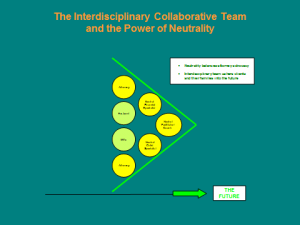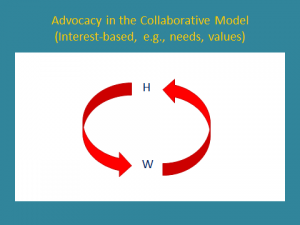 A friend of mine who knows I am intricately woven into the divorce-planning and alternative dispute resolution circles in the Minneapolis St. Paul metro recently asked me if I knew a certain divorce attorney. He knew of a person who was not feeling too well about their choice of a divorce attorney. I told my friend that I did not recognize the name.
Being a little curious, I searched the web for this individual. What I found was that family law was one of about eight other areas of law this person practiced. I wondered just how much family law this attorney does in relationship to all the other practice areas listed. Little does my friend know, his question inspired my writing this blog post.
Would you go to a painter if you needed a new roof? Would you go to a heart surgeon for a fractured arm? Hardly, you say. Why is it then when people have decided to end their marriage they first choose to see someone who is not a subject matter expert in the areas causing conflict between them and their spouse? They want this person to fix all their problems when that person probably does not have all the skill sets to solve all of the issues that present themselves in a divorce. I would submit that there is no one person who has all the skill sets necessary to effectively deal with all the intricacies of a divorce.
Perhaps the conflict is about co-parenting the couple’s children. Would it make sense to seek out a neutral child specialist to help the parents sort out the rough spots and more importantly benefit their children for years and really for their lifetime? Maybe the conflict is over financial matters. You would think a neutral financial specialist would be able to offer the most value to the couple in those situations. A couple not able to communicate effectively may benefit the most by seeing a neutral divorce relationship coach who can help both spouses manage their emotions which in turn frees up the flexible thinking they will need as they work through getting unmarried. If legal questions arise, you would think an attorney who primarily works in family law matters would be the best resource.
What I have described above is the client centered team model approach to a collaborative divorce. A team of professional experts in their own subject matter areas working for you and your family’s behalf. If you would like to learn more about this respectful and dignified way to divorce without court click on www.collaborativelaw.org to check it out.
A friend of mine who knows I am intricately woven into the divorce-planning and alternative dispute resolution circles in the Minneapolis St. Paul metro recently asked me if I knew a certain divorce attorney. He knew of a person who was not feeling too well about their choice of a divorce attorney. I told my friend that I did not recognize the name.
Being a little curious, I searched the web for this individual. What I found was that family law was one of about eight other areas of law this person practiced. I wondered just how much family law this attorney does in relationship to all the other practice areas listed. Little does my friend know, his question inspired my writing this blog post.
Would you go to a painter if you needed a new roof? Would you go to a heart surgeon for a fractured arm? Hardly, you say. Why is it then when people have decided to end their marriage they first choose to see someone who is not a subject matter expert in the areas causing conflict between them and their spouse? They want this person to fix all their problems when that person probably does not have all the skill sets to solve all of the issues that present themselves in a divorce. I would submit that there is no one person who has all the skill sets necessary to effectively deal with all the intricacies of a divorce.
Perhaps the conflict is about co-parenting the couple’s children. Would it make sense to seek out a neutral child specialist to help the parents sort out the rough spots and more importantly benefit their children for years and really for their lifetime? Maybe the conflict is over financial matters. You would think a neutral financial specialist would be able to offer the most value to the couple in those situations. A couple not able to communicate effectively may benefit the most by seeing a neutral divorce relationship coach who can help both spouses manage their emotions which in turn frees up the flexible thinking they will need as they work through getting unmarried. If legal questions arise, you would think an attorney who primarily works in family law matters would be the best resource.
What I have described above is the client centered team model approach to a collaborative divorce. A team of professional experts in their own subject matter areas working for you and your family’s behalf. If you would like to learn more about this respectful and dignified way to divorce without court click on www.collaborativelaw.org to check it out.  A friend of mine who knows I am intricately woven into the divorce-planning and alternative dispute resolution circles in the Minneapolis St. Paul metro recently asked me if I knew a certain divorce attorney. He knew of a person who was not feeling too well about their choice of a divorce attorney. I told my friend that I did not recognize the name.
Being a little curious, I searched the web for this individual. What I found was that family law was one of about eight other areas of law this person practiced. I wondered just how much family law this attorney does in relationship to all the other practice areas listed. Little does my friend know, his question inspired my writing this blog post.
Would you go to a painter if you needed a new roof? Would you go to a heart surgeon for a fractured arm? Hardly, you say. Why is it then when people have decided to end their marriage they first choose to see someone who is not a subject matter expert in the areas causing conflict between them and their spouse? They want this person to fix all their problems when that person probably does not have all the skill sets to solve all of the issues that present themselves in a divorce. I would submit that there is no one person who has all the skill sets necessary to effectively deal with all the intricacies of a divorce.
Perhaps the conflict is about co-parenting the couple’s children. Would it make sense to seek out a neutral child specialist to help the parents sort out the rough spots and more importantly benefit their children for years and really for their lifetime? Maybe the conflict is over financial matters. You would think a neutral financial specialist would be able to offer the most value to the couple in those situations. A couple not able to communicate effectively may benefit the most by seeing a neutral divorce relationship coach who can help both spouses manage their emotions which in turn frees up the flexible thinking they will need as they work through getting unmarried. If legal questions arise, you would think an attorney who primarily works in family law matters would be the best resource.
What I have described above is the client centered team model approach to a collaborative divorce. A team of professional experts in their own subject matter areas working for you and your family’s behalf. If you would like to learn more about this respectful and dignified way to divorce without court click on www.collaborativelaw.org to check it out.
A friend of mine who knows I am intricately woven into the divorce-planning and alternative dispute resolution circles in the Minneapolis St. Paul metro recently asked me if I knew a certain divorce attorney. He knew of a person who was not feeling too well about their choice of a divorce attorney. I told my friend that I did not recognize the name.
Being a little curious, I searched the web for this individual. What I found was that family law was one of about eight other areas of law this person practiced. I wondered just how much family law this attorney does in relationship to all the other practice areas listed. Little does my friend know, his question inspired my writing this blog post.
Would you go to a painter if you needed a new roof? Would you go to a heart surgeon for a fractured arm? Hardly, you say. Why is it then when people have decided to end their marriage they first choose to see someone who is not a subject matter expert in the areas causing conflict between them and their spouse? They want this person to fix all their problems when that person probably does not have all the skill sets to solve all of the issues that present themselves in a divorce. I would submit that there is no one person who has all the skill sets necessary to effectively deal with all the intricacies of a divorce.
Perhaps the conflict is about co-parenting the couple’s children. Would it make sense to seek out a neutral child specialist to help the parents sort out the rough spots and more importantly benefit their children for years and really for their lifetime? Maybe the conflict is over financial matters. You would think a neutral financial specialist would be able to offer the most value to the couple in those situations. A couple not able to communicate effectively may benefit the most by seeing a neutral divorce relationship coach who can help both spouses manage their emotions which in turn frees up the flexible thinking they will need as they work through getting unmarried. If legal questions arise, you would think an attorney who primarily works in family law matters would be the best resource.
What I have described above is the client centered team model approach to a collaborative divorce. A team of professional experts in their own subject matter areas working for you and your family’s behalf. If you would like to learn more about this respectful and dignified way to divorce without court click on www.collaborativelaw.org to check it out. 

 Divorce is a crisis in the life of a family. It is not actually a legal crisis, though it requires this expertise to ensure that legal resolutions are reached regarding financial matters. It is not a theoretical crisis. It is a genuine emotional crisis. What does this mean for children?
Some years after I began my therapy practice with children and families decades ago, a researcher named Judith Wallerstein published the results of her longitudinal study on the negative impact of divorce on children. The data were a wake-up call, shocking to some, sobering to all. Mental health experts responded by saying parents and social institutions needed to be more attentive to the impact of divorce on children. A book was written advocating bird nesting—parents rather than children transitioning to and from the homestead—as an alternative “custody” arrangement for families (an option we now know to be a temporary rather than permanent solution). Questions began to be raised on the impact of parenting time arrangements that essentially minimized otherwise healthy and loving relationships between parents and children.
At the time Wallerstein’s study was published, the options available for divorcing parents were largely adversarial in nature. The focus was “rights based,” not based on supporting co-parenting and keeping children out of the middle of the crisis. Many of the parents with whom I work attest to the emotional trauma they experienced when their own parents divorced. In fact, it is likely these divorcing parents were assured by their attorneys that “children are resilient—your kids will be fine.” But we know that children do not become resilient in a vacuum. They need adults to create environments of support and attention to their needs.
Collaborative team divorce offers a clear and powerful alternative for parents who love their children and want to envision a hopeful future for them. Families work with a multidisciplinary team of professionals with specific skills and experience. Mental health expertise is woven throughout the process, both to specifically support children and to provide parents with the best possible grounding for effective co-parenting. If you want to know more about how your family can weather the emotional crisis of divorce with the most dignity and respect for the needs of your children, please learn more about Collaborative team practice at this link to the website for the
Divorce is a crisis in the life of a family. It is not actually a legal crisis, though it requires this expertise to ensure that legal resolutions are reached regarding financial matters. It is not a theoretical crisis. It is a genuine emotional crisis. What does this mean for children?
Some years after I began my therapy practice with children and families decades ago, a researcher named Judith Wallerstein published the results of her longitudinal study on the negative impact of divorce on children. The data were a wake-up call, shocking to some, sobering to all. Mental health experts responded by saying parents and social institutions needed to be more attentive to the impact of divorce on children. A book was written advocating bird nesting—parents rather than children transitioning to and from the homestead—as an alternative “custody” arrangement for families (an option we now know to be a temporary rather than permanent solution). Questions began to be raised on the impact of parenting time arrangements that essentially minimized otherwise healthy and loving relationships between parents and children.
At the time Wallerstein’s study was published, the options available for divorcing parents were largely adversarial in nature. The focus was “rights based,” not based on supporting co-parenting and keeping children out of the middle of the crisis. Many of the parents with whom I work attest to the emotional trauma they experienced when their own parents divorced. In fact, it is likely these divorcing parents were assured by their attorneys that “children are resilient—your kids will be fine.” But we know that children do not become resilient in a vacuum. They need adults to create environments of support and attention to their needs.
Collaborative team divorce offers a clear and powerful alternative for parents who love their children and want to envision a hopeful future for them. Families work with a multidisciplinary team of professionals with specific skills and experience. Mental health expertise is woven throughout the process, both to specifically support children and to provide parents with the best possible grounding for effective co-parenting. If you want to know more about how your family can weather the emotional crisis of divorce with the most dignity and respect for the needs of your children, please learn more about Collaborative team practice at this link to the website for the 
 I heard an advertisement on the radio this morning for a litigating divorce attorney. This attorney discussed the importance of removing the emotion from divorce and treating the divorce itself as a business transaction. I understood her point – emotions can be messy or interfere with rational decision making. However, emotion is often the biggest part of divorce. Or, it often feels that way to clients.
How can we ask clients to strip that piece out of the process? Rather, as a collaborative attorney, I believe that emotion can be used to healthily guide clients to mutually agreeable resolutions that have long-term staying power. I embrace the opportunity to take the client where they are at – emotions and all – and guide them towards resolution. Engaging a mental health professional or coach in the process can sometimes be the greatest asset provided to clients and allow them to balance the emotions with the necessary business-like decisions.
Treating a divorce as a business transaction often leads to client’s making decisions for purely financial reasons. Using emotions and feelings of fairness or equity may lead to clients feeling as if the resolutions more completely address their needs.
For example, if one spouse cheated on the other, an emotional response of anger or vindication may lead to the hurt spouse to ask for more financial pay-out. This sort of punitive outcome is not supported in the law and rarely agreed to out-of-court. However, if the parties have a co-parenting relationship or more emotional needs, a purely business-like interaction may never address some of the underlying emotions. Facilitating a discussion about how both parties are feeling and what they may need in order to move forward may been more beneficial to the clients than any financial resolution. Some clients want an apology or a better understanding of why something happened. Others may need to put in effort to establish a shared narrative or story for others.
The finances matter – sometimes most of all. The collaborative process embraces the financial side of divorce, but also allows for a more holistic and complete approach that can address emotions, if the clients so desire.
I heard an advertisement on the radio this morning for a litigating divorce attorney. This attorney discussed the importance of removing the emotion from divorce and treating the divorce itself as a business transaction. I understood her point – emotions can be messy or interfere with rational decision making. However, emotion is often the biggest part of divorce. Or, it often feels that way to clients.
How can we ask clients to strip that piece out of the process? Rather, as a collaborative attorney, I believe that emotion can be used to healthily guide clients to mutually agreeable resolutions that have long-term staying power. I embrace the opportunity to take the client where they are at – emotions and all – and guide them towards resolution. Engaging a mental health professional or coach in the process can sometimes be the greatest asset provided to clients and allow them to balance the emotions with the necessary business-like decisions.
Treating a divorce as a business transaction often leads to client’s making decisions for purely financial reasons. Using emotions and feelings of fairness or equity may lead to clients feeling as if the resolutions more completely address their needs.
For example, if one spouse cheated on the other, an emotional response of anger or vindication may lead to the hurt spouse to ask for more financial pay-out. This sort of punitive outcome is not supported in the law and rarely agreed to out-of-court. However, if the parties have a co-parenting relationship or more emotional needs, a purely business-like interaction may never address some of the underlying emotions. Facilitating a discussion about how both parties are feeling and what they may need in order to move forward may been more beneficial to the clients than any financial resolution. Some clients want an apology or a better understanding of why something happened. Others may need to put in effort to establish a shared narrative or story for others.
The finances matter – sometimes most of all. The collaborative process embraces the financial side of divorce, but also allows for a more holistic and complete approach that can address emotions, if the clients so desire. 



 In
In 
